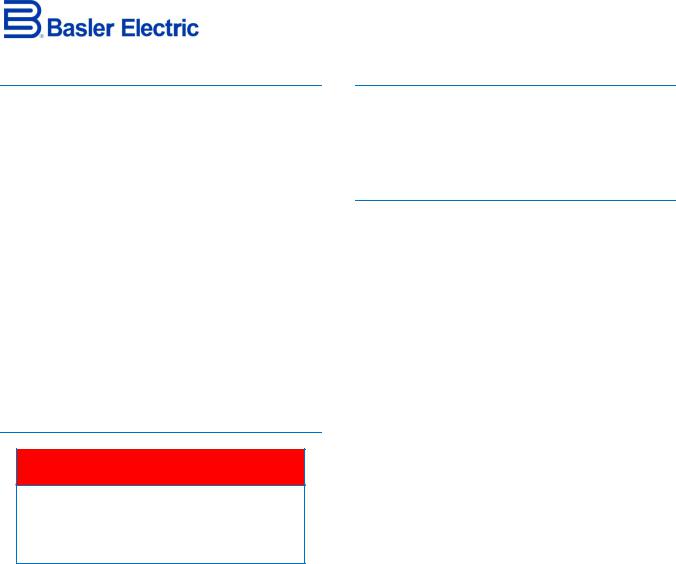Basler Electric SMC-250 User Manual

|
www.basler.com |
SMC-250 Synchronous Motor Controller |
|
+1 618.654.2341 (USA) |
System Overview |
|
info@basler.com |
|
|
|
|
INTRODUCTION
The Basler Electric SMC-250 Synchronous Motor Controller precisely and reliably controls the level of excitation power supplied to the field of a brushless synchronous motor. Field excitation power is delivered and controlled by a DECS-250 Digital Excitation Control System. Comprehensive motor protection is provided by a BE1-11m Motor Protection System. Coordinated programming of the DECS-250 and BE1-11m yields efficient control of the machine and minimizes machine downtime.
The DECS-250, BE1-11m, control relays, and connection terminals are mounted and wired on a single mounting plate or pan chassis intended for installation in a suitable enclosure.
This publication serves as an overview of the functions and capabilities available in the SMC-250. System drawings and product documentation specific to the devices of the SMC-250 accompany this publication.
SAFETY
Warning!
Personal injury may result if contact is made with system components carrying high voltages. The circuit diagrams, supplied with this document, will disclose hazardous areas.
As with all electrical equipment, appropriate safety measures must be taken whenever dealing with the excitation equipment. High voltages are present at the equipment. The voltage magnitudes depend upon the characteristics of a particular system. Opening the power source connections does not completely remove the threat of high voltages. As long as the machine is physically connected to the system, the possibility of a safety hazard exists.
When working with the excitation control switchgear, every precaution must be taken to ensure that all high voltages are isolated and avoided. In addition to voltage at the PPT, there may be other power sources connected to the equipment. These sources may include the user-supplied dc control power and the ac station power. Consider all connections to be live and dangerous until proven otherwise.
HANDLING AND MAINTENANCE
Careful handling and routine maintenance will promote SMC-250 longevity and preserve its performance. Basler Electric publication 9410100990, supplied with this publication, provides guidelines for handling, installing, and maintaining the SMC-250.
EQUIPMENT OVERVIEW
SMC-250 features and options are defined and specified by a style number derived from the style chart shown in Figure 1.
Standard equipment elements include a DECS-250 Digital Excitation Control System, BE1-11m Motor Protection System, BE3-74SD DC Millivolt Sensing Relay (for overexcitation and underexcitation protection), auxiliary relays, a metering shunt, dc power supply, circuit breakers, and user terminals.
Mounting Configurations
One of two SMC-250 mounting configurations may be specified. Components are mounted and wired on a mounting plate (style xxxxxxMx) or a pan chassis (style xxxxxxPx).
The mounting plate is constructed from 1.5 millimeter, galvanized steel. Mounting plate dimensions are shown on an outline drawing which accompanies this publication.
The pan chassis is constructed from 11 gauge steel and finished with a light-gray, thermoset polymer coating. Pan chassis dimensions are shown on an outline drawing which accompanies this publication.
Terminal Configurations
One of two SMC-250 terminal configurations may be specified. User connections to the SMC-250 are made with spring terminals (style xxxxxxxS) or compression (screw) terminals (style xxxxxxxC). Both terminal types accommodate wire sizes over the range of 24 to 12 AWG or 0.2 mm2 to 2.5 mm2. When wiring to spring terminals or compression terminals a wire insulation stripping length of 8 to 10 millimeters (0.315 to 0.394 inches) is recommended.
When tightening the connection screws of compression terminals, apply a torque no greater
than 0.6 N•m or 5.3 in-lb.
Control and Indication
SMC-250 controls consist of user-supplied switches and contacts which connect to the plate/chassis
Publication |
Revision |
Instructions |
Date |
Copyright |
9494900994 |
A |
10/14 |
2014 |
For terms of service relating to this product and software, see the Commercial Terms of Products and Services document available at www.basler.com/terms.

terminals. Switch and contact inputs are commonly used for start and stop control of the SMC-250, setpoint adjustment, and operating mode control.
System indications are provided through output contacts from the DECS-250, BE1-11m, and BE374SD. Output contact connections are made at the plate/chassis terminal blocks.
External Accessories
Optional, external accessories include an Analog Expansion Module (AEM-2020), a Contact Expansion Module (CEM-2020), an RTD Module, and an Interactive Display Panel (IDP-800).
Analog Expansion Module (AEM-2020)
DECS-250 inputs and outputs may be augmented with the following analog inputs and outputs of the AEM-2020:
•Eight analog inputs
•Eight RTD (resistance temperature detector) inputs
•Two thermocouple (temperature) inputs
•Four analog outputs
AEM-2020 input and output states are communicated to and from the DECS-250 via CANbus. Input thresholds can be configured and programmed using BESTCOMSPlus® and BESTlogic™Plus. Outputs are intended to drive external, analog meters and can be configured for indication of motor values and other parameters.
AEM-2020 details and specifications are provided in the DECS-250 instruction manual (Basler publication 9440300990).
Contact Expansion Module (CEM-2020/CEM-2020H)
The CEM-2020 or CEM-2020H can be specified to provide the following additional combinations of DECS-250 contact inputs and outputs:
•Ten contact inputs
•Eighteen contact outputs (CEM-2020H) or twenty-four contact outputs (CEM-2020)
CEM-2020 input and output contact states are communicated to and from the DECS-250 via CANbus. Input and output functions are assigned using BESTlogic™Plus.
RTD Module
BE1-11m RTD (resistance temperature detector) inputs, analog inputs, and analog outputs can be augmented with the available RTD module. The RTD module provides:
•Twelve RTD inputs
•Four analog inputs
•Four analog outputs
Each RTD input is configurable to protect against high or low motor temperatures. Programmable over
and under thresholds for the analog inputs can be used to trigger a protection element within the BE1-11m. The analog outputs can be configured to provide real-time metering of individual motor parameters.
RTD module details and specifications are provided in the BE1-11m instruction manual (Basler publication 9424200996).
Interactive Display Panel (IDP-800)
A 7.5-inch (19-centimeter) touch-panel can be installed locally or remotely to:
•View analog and digital system parameters
•Configure motor control, limiter, and protection settings
•Download system data recorded by the DECS-250
Details about the IDP-800 are available in Basler publication 9437600990.
SYSTEM ELEMENTS
Interconnected SMC-250 system elements work together to supply regulated excitation power to the field and protect the controlled equipment. All excitation system element connections are illustrated on the system interconnection diagrams.
Inputs and Outputs
SMC-250 inputs and outputs consist of power and sensing inputs, control inputs and outputs, the field output, and communication ports. For input and output connections, refer to the appropriate interconnection diagram provided with this publication.
Control Power
Control power is determined by the SMC-250 style number and can be 120 Vac (style xxx1xxxx) or
24 Vdc (style xxx2xxxx). When 24 Vdc control power is specified, the SMC-250 has a station power input range of 85 to 264 Vac or 90 to 350 Vdc.
Operating Power
SMC-250 operating power is typically supplied by an external PPT sized for the application.
Sensing Inputs
SMC-250 sensing voltage and sensing current are supplied by external VTs and CTs configured to supply three-phase sensing to the DECS-250 and BE1-11m. The VTs and CTs must be sized appropriately for the application and compatibility with the SMC-250. The CTs may have a secondary rating of 1 Aac (style xxxxx1xx) or 5 Aac (style xxxxx5xx).
Field Output
To obtain optimum metering resolution of the field current, one of three field output ranges may be specified to suit the application requirements, an
Publication |
Revision |
Instructions |
Date |
Page |
9494900994 |
A |
10/14 |
2 of 6 |
